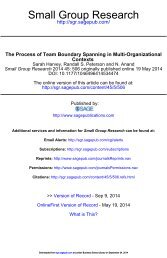A Dynamic Perspective on Diverse Teams: Moving From The Dual Process Model to A Dynamic Coordination-Based Model of Diverse Team Performance - Kannan Srikanth, Sarah Harvey & Randall Peterson
The existing literature on diverse teams suggests that diversity is both helpful to teams in making more information available and encouraging creativity and damaging to teams in reducing cohesion and information sharing. Thus the extant literature suggests that diversity within teams is a double-edged sword that leads to both positive and negative effects simultaneously.
The existing literature on diverse teams suggests that diversity is both helpful to teams in making more information available and encouraging creativity and
damaging to teams in reducing cohesion and information sharing. Thus the
extant literature suggests that diversity within teams is a double-edged sword
that leads to both positive and negative effects simultaneously.
Create successful ePaper yourself
Turn your PDF publications into a flip-book with our unique Google optimized e-Paper software.
18 † <strong>The</strong> Academy <strong>of</strong> Management Annals<br />
Downloaded by [L<strong>on</strong>d<strong>on</strong> Business School Library], [<strong>Randall</strong> Peters<strong>on</strong>] at 06:11 31 January 2016<br />
by taking measurements at different points in time. First, as expected from the<br />
dual-process model, these studies find that diverse groups benefit from possessing<br />
and sharing different informati<strong>on</strong>. However, these groups are also less<br />
likely <strong>to</strong> integrate their diverse informati<strong>on</strong> in forming soluti<strong>on</strong>s, thereby not<br />
truly taking advantage <strong>of</strong> their diverse informati<strong>on</strong>al resources. For example,<br />
Dahlin, Weingart, and Hinds (2005) counted the number <strong>of</strong> pieces <strong>of</strong> unique<br />
informati<strong>on</strong> shared by group members and found that student groups<br />
working <strong>to</strong>gether over a seven-week period who were diverse in educati<strong>on</strong>al<br />
background shared more informati<strong>on</strong> and discussed that informati<strong>on</strong> in<br />
greater depth than groups with less diversity. However, those groups also integrated<br />
less <strong>of</strong> their informati<strong>on</strong> <strong>to</strong> form soluti<strong>on</strong>s, suggesting that deep-level<br />
diversity makes it difficult for groups <strong>to</strong> coordinate informati<strong>on</strong>. Moreover,<br />
Van der Vegt, Bunders<strong>on</strong>, and Oosterh<strong>of</strong> (2006) found that student teams<br />
with high levels <strong>of</strong> diversity in expertise had asymmetric patterns <strong>of</strong> helping,<br />
such that members were more willing <strong>to</strong> help those they perceived as more<br />
expert. Taken <strong>to</strong>gether, these studies suggest that informati<strong>on</strong> is not always efficiently<br />
coordinated in diverse groups. Supporting this specific c<strong>on</strong>clusi<strong>on</strong>,<br />
Klein, Knight, Ziegert, Lim, and Saltz (2011) found that diversity has a more<br />
positive effect <strong>on</strong> team outcomes in the presence <strong>of</strong> modera<strong>to</strong>rs that aid coordinati<strong>on</strong>,<br />
as opposed <strong>to</strong> modera<strong>to</strong>rs that decrease negative interpers<strong>on</strong>al processes<br />
such as low cohesi<strong>on</strong>. <strong>The</strong> studies <strong>on</strong> the informati<strong>on</strong>al benefits <strong>of</strong><br />
deep-level diversity have not always detected the informati<strong>on</strong> coordinati<strong>on</strong><br />
issues faced by diverse groups since <strong>of</strong>ten they focus <strong>on</strong> tasks in which no<br />
coordinati<strong>on</strong> between group members is required (<strong>Harvey</strong>, 2013).<br />
In sum, our review suggests that it is currently unclear whether social categorizati<strong>on</strong><br />
is at the root <strong>of</strong> performance problems in diverse groups because<br />
the majority <strong>of</strong> studies <strong>to</strong> date have taken measures over relatively l<strong>on</strong>g time<br />
scales and made theoretical assumpti<strong>on</strong>s about how the intervening process<br />
led <strong>to</strong> l<strong>on</strong>ger term outcomes. Our review also suggests that the negative<br />
effects <strong>of</strong> diversity may also be caused by failures <strong>to</strong> coordinate due <strong>to</strong> the complexity<br />
<strong>of</strong> managing diverse informati<strong>on</strong>. To delve further in<strong>to</strong> the roles <strong>of</strong><br />
informati<strong>on</strong> and coordinati<strong>on</strong> versus social and interpers<strong>on</strong>al processes in<br />
diverse groups over time, we turn now <strong>to</strong> examining studies <strong>of</strong> diversity c<strong>on</strong>ducted<br />
over shorter time spans.<br />
Short-term Studies <strong>of</strong> Newly Formed <strong>Diverse</strong> Groups<br />
Studies that measure diversity in the short term by studying newly formed<br />
experimental groups that interact over a matter <strong>of</strong> minutes or hours, or by<br />
taking very precise measures <strong>of</strong> behavior during group interacti<strong>on</strong>s, paint a<br />
different picture <strong>of</strong> the role <strong>of</strong> informati<strong>on</strong>al and social processes than<br />
studies that take place over weeks and m<strong>on</strong>ths. Our review <strong>of</strong> these studies<br />
suggests that informati<strong>on</strong>al diversity can lead <strong>to</strong> coordinati<strong>on</strong> problems in
















